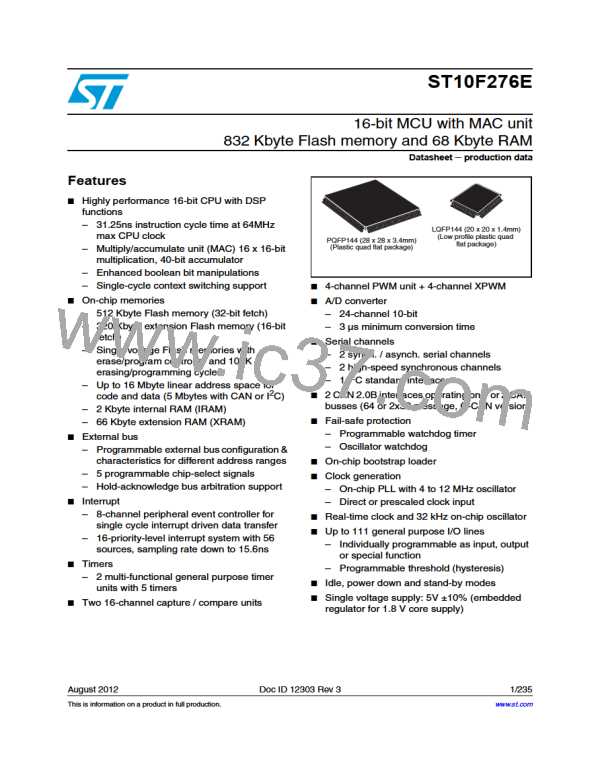Real-time clock
ST10F276E
17
Real-time clock
The Real-Time Clock is an independent timer, in which the clock is derived directly from the
clock oscillator on XTAL1 (main oscillator) input or XTAL3 input (32 kHz low-power oscillator)
so that it can be kept on running even in Idle or Power down mode (if enabled to). Registers
access is implemented onto the XBUS. This module is designed with the following
characteristics:
●
Generation of the current time and date for the system
●
Cyclic time based interrupt, on Port2 external interrupts every ‘RTC basic clock tick’
and after n ’RTC basic clock ticks’ (n is programmable) if enabled
●
●
58-bit timer for long term measurement
Capability to exit the ST10 chip from Power down mode (if PWDCFG of SYSCON set)
after a programmed delay
The real-time clock is based on two main blocks of counters. The first block is a prescaler
which generates a basic reference clock (for example a 1 second period). This basic
reference clock is coming out of a 20-bit DIVIDER. This 20-bit counter is driven by an input
clock derived from the on-chip CPU clock, pre-divided by a 1/64 fixed counter. This 20-bit
counter is loaded at each basic reference clock period with the value of the 20-bit
PRESCALER register. The value of the 20-bit RTCP register determines the period of the
basic reference clock.
A timed interrupt request (RTCSI) may be sent on each basic reference clock period. The
second block of the RTC is a 32-bit counter that may be initialized with the current system
time. This counter is driven with the basic reference clock signal. In order to provide an
alarm function the contents of the counter is compared with a 32-bit alarm register. The
alarm register may be loaded with a reference date. An alarm interrupt request (RTCAI),
may be generated when the value of the counter matches the alarm register.
The timed RTCSI and the alarm RTCAI interrupt requests can trigger a fast external
interrupt via EXISEL register of port 2 and wake-up the ST10 chip when running power
down mode. Using the RTCOFF bit of RTCCON register, the user may switch off the clock
oscillator when entering the power down mode.
The last function implemented in the RTC is to switch off the main on-chip oscillator and the
32 kHz on-chip oscillator if the ST10 enters the Power Down mode, so that the chip can be
fully switched off (if RTC is disabled).
At power on, and after Reset phase, if the presence of a 32 kHz oscillation on XTAL3 /
XTAL4 pins is detected, then the RTC counter is driven by this low frequency reference
clock: when Power Down mode is entered, the RTC can either be stopped or left running,
and in both the cases the main oscillator is turned off, reducing the power consumption of
the device to the minimum required to keep on running the RTC counter and relative
reference oscillator. This is valid also if Stand-by mode is entered (switching off the main
supply VDD), since both the RTC and the low power oscillator (32 kHz) are biased by the
V
STBY. Vice versa, when at power on and after Reset, the 32 kHz is not present, the main
oscillator drives the RTC counter, and since it is powered by the main power supply, it
cannot be maintained running in Stand-by mode, while in Power Down mode the main
oscillator is maintained running to provide the reference to the RTC module (if not disabled).
104/235
Doc ID 12303 Rev 3

 STMICROELECTRONICS [ ST ]
STMICROELECTRONICS [ ST ]